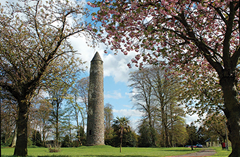Strategic district with good quality of life
 Antrim and Newtownabbey covers a mixture of countryside and urban areas, and benefits from a strategic location and a healthy population. agendaNi reviews its main characteristics.
Antrim and Newtownabbey covers a mixture of countryside and urban areas, and benefits from a strategic location and a healthy population. agendaNi reviews its main characteristics.
Transport and infrastructure
The Antrim and Newtownabbey area has a strategic place in the Northern Ireland Regional Development Strategy (RDS). Newtownabbey is criss-crossed by two key transport corridors (M2 and A8) and the railway lines to Derry and Larne. Its urban part lies within the Belfast Metropolitan Urban Area, which also incorporates Lisburn and Bangor.
Newtownabbey benefits from its close proximity to retail, cultural and educational opportunities in Belfast. Belfast Lough and the Belfast hills “constrain the direction of future growth” and the RDS acknowledges that there is significant deprivation in the Monkstown area.
Antrim town is a ‘main hub’ settlement with Belfast International Airport located just six miles away. Despite the new council arrangement, the strategy proposes a cluster between Antrim, Ballymena and Larne. The cluster would promote balanced regional development in the north east as opposed to a concentration in Belfast itself.
The town is recognised for its “expanding retail offer” and its principal strength “literally revolves around a well developed transport infrastructure”. Antrim’s four main economic drivers are construction, distribution, transport and hospitality. Its tourism potential is associated with its proximity to Lough Neagh and the lough’s tributary rivers which provide opportunities for watersports, scenic walks and angling.
Health
In the 2001 census, almost half of residents in Antrim (49.5 per cent) and Newtownabbey (47 per cent) declared themselves as being in ‘very good health’. This compares well with the province-wide figure of 47.7 per cent.
When results for ‘good health’ are added, the healthy proportion of the population rises to 82.2 per cent in Antrim and 80.4 per cent in Newtownabbey: both above the 79.5 per cent Northern Ireland rate. A small percentage of residents were in ‘bad health’ or ‘very bad health’ i.e. 4.4 per cent in Antrim, 5.2 per cent in Newtownabbey and 5.6 per cent across the province.
The census also measured the proportion of people living with long-term health problems or disabilities. Both councils were under the Northern Ireland average: 18.1 per cent in Antrim and 19.6 per cent in Newtownabbey compared to the regional 20.7 per cent.
The most recent life expectancy figure for Northern Ireland (2008-2010) was 77.1 years for men and 81.5 for women.
Male life expectancy was higher in Antrim (78.1) and Newtownabbey (78.0). Female life expectancy was higher than average in Newtownabbey (81.9) but slightly lower than average (81.2) in Antrim.
Both councils are located in the Northern Health and Social Care Trust’s area. Key facilities include Antrim Area Hospital (acute) and Whiteabbey Hospital (sub-acute).
Education
The most recent educational statistics at local government level were published in 2009-2010. In all major indicators, performances by pupils in Antrim were higher than those in Newtownabbey but most results for either district followed regional trends.
82.5 per cent of pupils across Northern Ireland attained the expected levels in Key Stage 2 maths. Pupils in Antrim almost matched that level (81.8 per cent) and the proportion in Newtownabbey was slightly lower, at 78.9 per cent. The same trend applied in tests for English: 81.4 per cent across Northern Ireland, 81.3 per cent in Antrim and 78.7 per cent in Newtownabbey.
The standard measure of success at GCSE level is five or more passes at grade C or above. The percentage in Newtownabbey
(71.6 per cent) was just below the Northern Ireland figure (71.9 per cent) but Antrim was slightly higher (73.4 per cent).
The share of Newtownabbey school leavers entering further education (33 per cent) was almost equal to the regional proportion
(33.1 per cent). Antrim’s figure was markedly higher at 41.9 per cent.
42.2 per cent of school leavers across Northern Ireland entered higher education. Newtownabbey’s figure was slightly smaller
(38.8 per cent) but Antrim was in line with the regional trend (41 per cent).
Lower performances in Newtownabbey can partly be explained by the higher proportion of pupils with special educational needs or who are entitled to free school meals; both of these are common challenges facing schools in urban areas (agendaNi issue 55, pages 48-49).
Antrim and Newtownabbey are currently covered by the transitional North Eastern Education and Library Board area, which is due to be subsumed into the Education and Skills Authority this year. Public libraries were transferred to the Northern Ireland Library Authority in April 2009.





